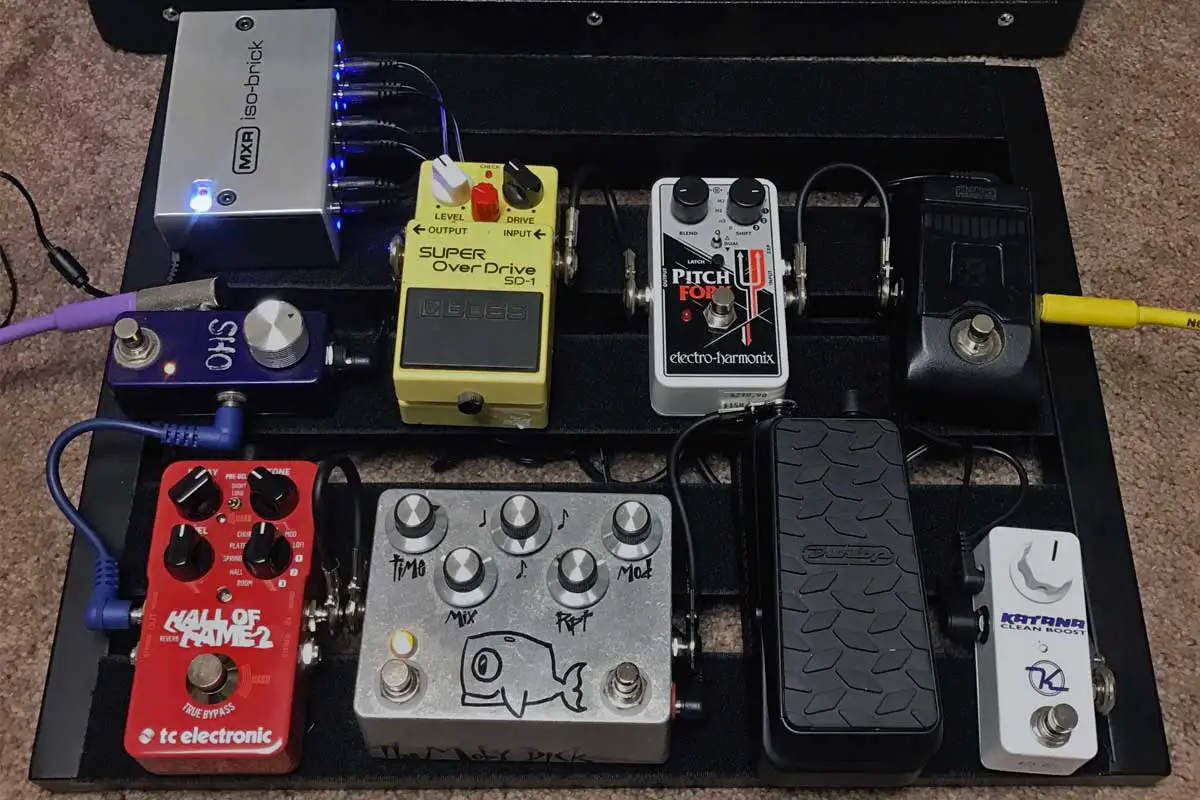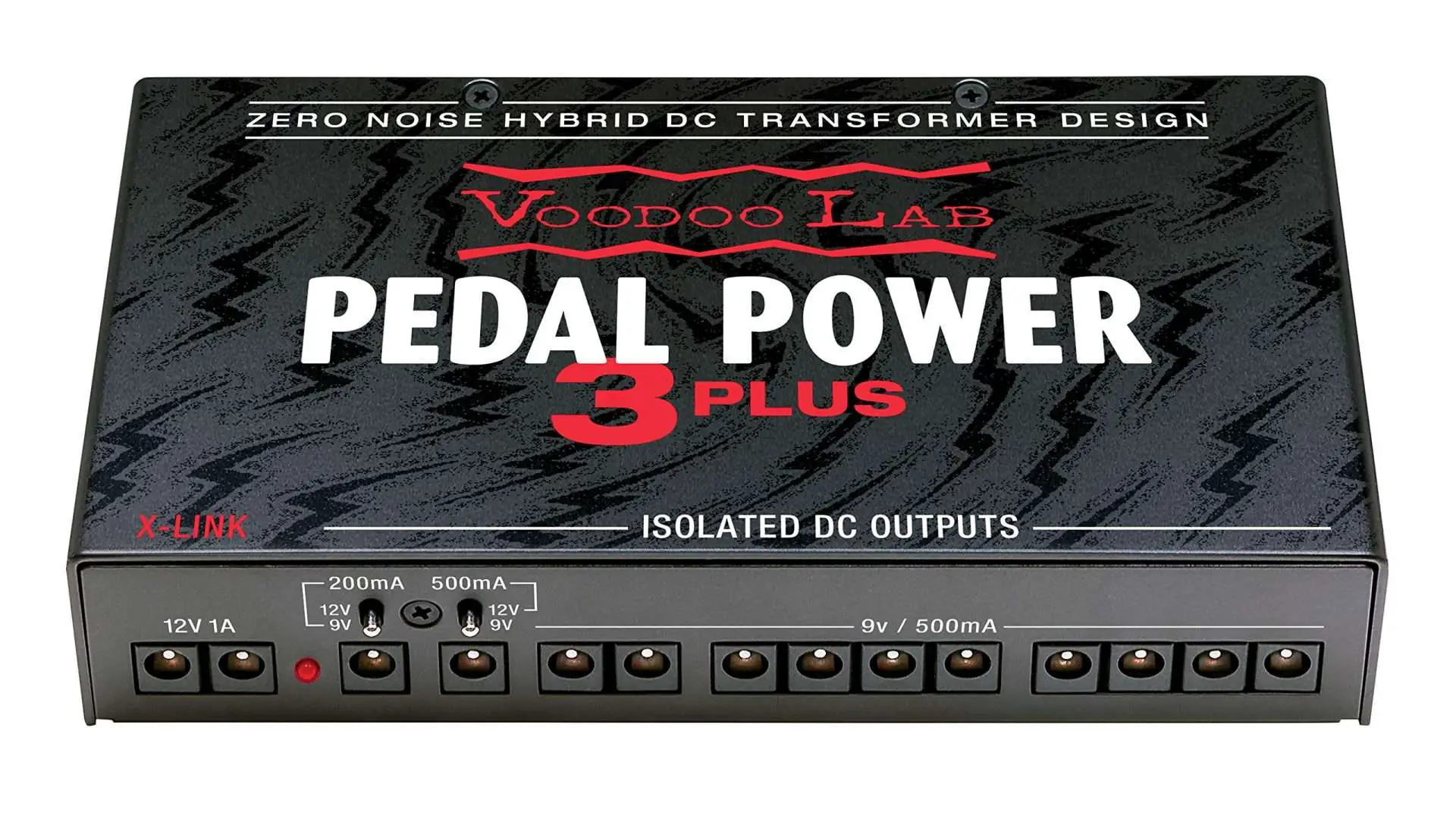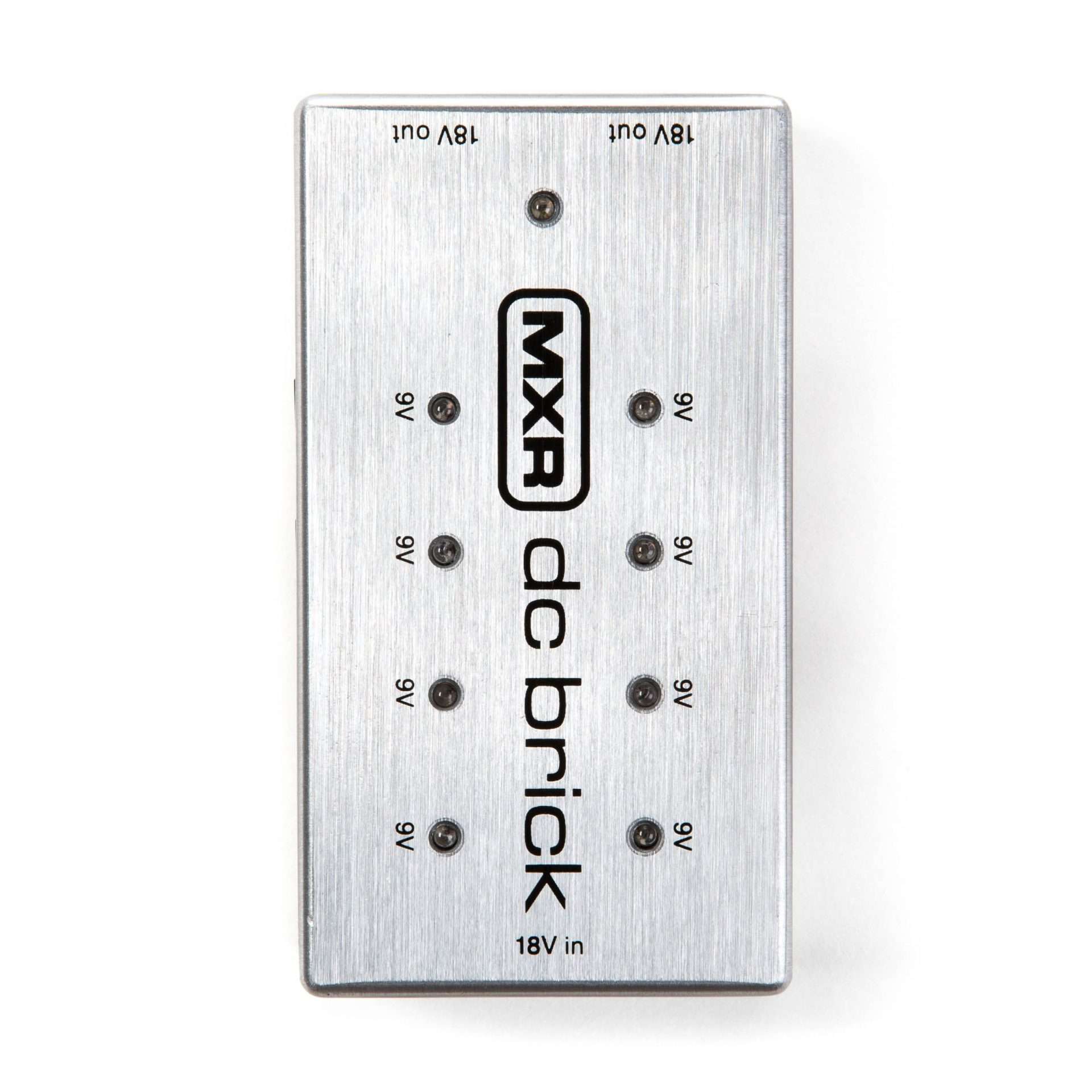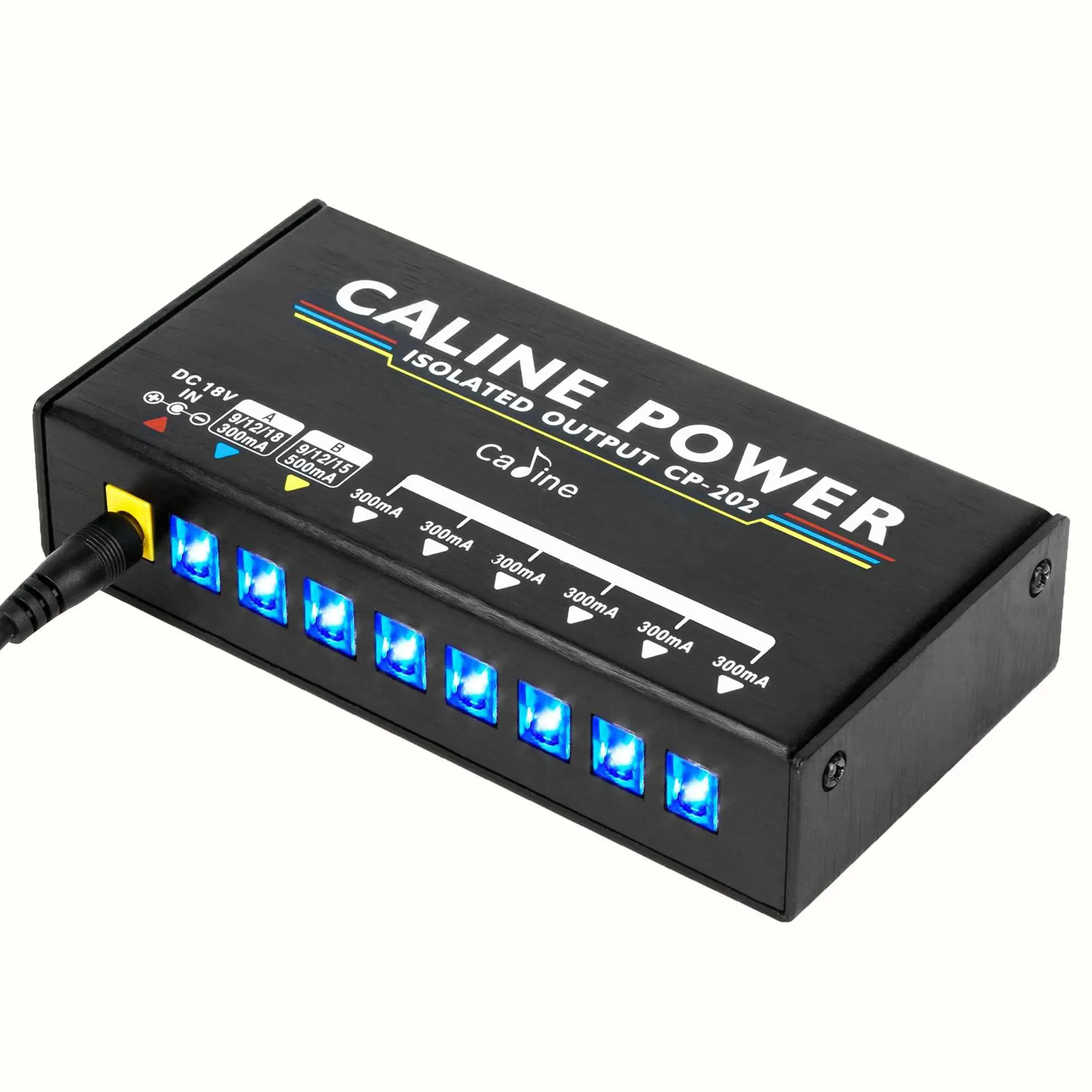For musicians, the quality of a performance can be heavily influenced by the reliability and organization of their equipment. This is especially true for guitarists and bassists who use a variety of pedals to shape their sound. Choosing the best pedalboard power supply is crucial as it ensures each pedal functions optimally without the hassle of individual batteries or a tangle of power adapters.
Choosing the right power supply for your pedalboard means considering various factors. The number of outputs, the voltage options, and the overall current capacity play vital roles in delivering clean, consistent power to every pedal. Some power supplies also offer isolated outputs to reduce noise, a common problem when daisy-chaining power to multiple pedals.
As we evaluate pedalboard power supplies, we focus on the balance between functionality, durability, and noise reduction. Power supplies that feature additional protection against short circuits and overvoltage ensure that pedals remain safe during use. We recognize that a good power supply is an investment into the longevity of a musician’s gear.
After comprehensive testing and consistency checks with various effects pedals, our recommendations are designed to help musicians find a power supply that will streamline their setup and enhance performance quality.

Top Pedalboard Power Supplies
We’ve carefully selected the finest pedalboard power supplies to ensure your effects pedals operate seamlessly during every performance. Our recommendations offer reliability, noise-free operation, and versatile connectivity options to power a wide range of pedals, fulfilling the needs of guitarists at all levels.
Voodoo Lab Pedal Power 3 PLUS

We believe the Voodoo Lab Pedal Power 3 PLUS is a game-changer for musicians seeking a silent and reliable power solution for their pedalboards.
Pros
- Isolated outputs eliminate noise interference between pedals
- High current capability caters to power-hungry DSP effects
- Expandable with X-LINK ports for additional outputs
Cons
- Premium pricing may be above some budgets
- Requires additional accessories for 18V or 24V pedals
- Potential overkill for smaller, less complex pedal setups
In our hands-on session, the Voodoo Lab Pedal Power 3 PLUS impressed us with its whisper-quiet performance. Each output’s isolation means that even the most sensitive pedals run without any hum or buzz, allowing the true tone of each effect to shine through. The build quality is exceptional, and despite its compact size, it feels like it can withstand the rigors of the road.
When testing the unit with high-draw digital pedals, the power supply didn’t break a sweat. The generous 500mA output per channel ensures that modern, current-hungry pedals receive all the power they need. The peace of mind that comes with a reliable power supply can’t be overstated—if you’ve ever experienced a pedal cutting out during a show, you know how crucial a stable power source is.
The expandable nature of the Voodoo Lab Pedal Power 3 PLUS is another standout feature. As our pedal collection grows, so can the power supply’s capabilities thanks to the X-LINK ports. It’s reassuring to know we can add additional isolated outputs without needing a whole new unit. Whether you’re playing a coffeehouse or embarking on a world tour, this power supply adapts effortlessly.
MXR Iso-Brick

For those of us in need of a reliable power supply for our pedalboards, the MXR Iso-Brick is a top-notch choice that combines compactness and functionality.
Pros
- Fits snugly under most pedalboards for a sleek setup
- Isolated power outputs reduce noise for a clearer sound
- Sturdy construction ensures it withstands the rigors of frequent use
Cons
- Comes with a DC power brick instead of a standard AC power cord
- The variable voltage outlets may not be useful for everyone
- Can be pricier than some alternatives, although the quality justifies the cost
Our experience with the MXR Iso-Brick Power Supply highlighted its strong points right away. The compact design meant we had no trouble fitting it under our Pedaltrain Jr., clearing up valuable real estate on the board itself. The solid build gave us confidence that it would endure the often rough-and-tumble reality of gigging and transport.
The isolated power outputs made the most significant difference—a noticeable drop in noise—compared to our old daisy chains. It’s clear that the isolated outputs are more than just a marketing gimmick; they contribute to a cleaner, more professional sound.
We’re wary of the included DC power brick; a built-in AC connection might have been more convenient. Yet, that’s a minor hiccup in what is otherwise a seamless experience. We didn’t find much use for the variable voltage features, but we can see how they’d be useful for musicians with specific power requirements. Despite the higher price tag, considering its performance and durability, the Iso-Brick feels like a wise investment.
Ernie Ball Volt

We find the Ernie Ball Volt to be an indispensable tool for any pedalboard, delivering clean and consistent power to multiple pedals with ease.
Pros
- Effortlessly powers a range of pedals with isolated outputs
- Space-saving design, perfect for cluttered pedalboards
- Versatile voltage options, accommodating typical 9V and larger 18V pedals
Cons
- Limited number of outputs for those with more extensive setups
- The size of the AC adapter may be cumbersome in some situations
- Included cables might need an upgrade for some users’ preferences
Our experience with the Ernie Ball Volt has been incredibly positive. Its sleek and sturdy design meant it nestled among our pedals without a hassle, and the isolated outputs ensured each pedal functioned without interference from others. We especially appreciated the dual voltage options; the 18V output brought new life to certain pedals that thrive on the extra headroom.
In performance environments, the real test of any gear is its reliability, and here the Volt didn’t disappoint. We noticed a marked reduction in noise compared to daisy chains, which can be vital when playing live. Also, the compact nature of the unit meant it was a breeze to incorporate into our existing rig.
Yet, despite its many strengths, we should consider a couple of aspects. The power supply has five outputs, which might not be enough for those with more extensive pedal collections. Moreover, while the AC adapter is universal—a great benefit for international power sources—it does carry a bit of bulk and could crowd tightly packed power strips.
In summary, the Ernie Ball Volt finds a sweet spot between power and size. It makes powering pedals simple and efficient, contributing to a stress-free setup. If your pedal array is moderate and you prize noise-free operation, this power supply would be a welcome addition to your board.
MXR DC Brick

We found the MXR DC Brick to be an essential and dependable ally on our pedalboard, delivering consistent power with added practicality.
Pros
- Compact design that fits snugly on our board
- Multiple outputs cater to numerous pedals
- LEDs for short detection promote peace of mind
Cons
- Only includes 9V and 18V outputs, limiting versatility
- Higher energy draw pedals could max out capacity
- Could benefit from more varied output voltages
We’ve been on the lookout for a solution to keep our array of pedals efficiently powered through gigs and sessions. When we hooked up the MXR DC Brick, we were pleasantly surprised by its no-fuss setup. The compactness is a real space-saver, allowing us to add an extra pedal in the space it could have occupied.
Performance-wise, the MXR DC Brick has been a stalwart. Every pedal in our setup gets the power it needs without any hassle. There’s a real sense of reliability with this one, which is what we’re always chasing, especially during live performances where there’s no room for error.
The short-circuit LEDs are a highlight, instantly alerting us to any issues so we can address them on the fly – a dream feature that adds to the reliability factor. Although its range of voltages may not cater to every pedal out there, for our current setup, it has been a perfect match. Admittedly, as we expand our pedal selection, we may need to look into additional power supply options, but for now, the DC Brick has lived up to its solid reputation.
Caline Power Supply

If you’re in the market for a reliable and noiseless pedalboard power supply, the Caline CP-202 would make a worthy addition to your setup.
Pros
- Effective noise reduction due to fully isolated outputs
- Lightweight and highly portable for musicians on-the-go
- Built-in short circuit protection for each output
Cons
- Provided power cables may be less durable than some expect
- Bright blue LED indicators might be distracting for some users
- Some users reported issues with power consistency on high-demand pedals
Our personal experience with the Caline CP-202 was undoubtedly positive. Setting it up was a breeze, and we noticed an immediate improvement in noise reduction, especially with our analog pedals. The fully isolated outputs lived up to their promise, providing clean power without the hum or buzz that can sometimes plague pedalboards.
We particularly enjoyed its portability. This power supply’s compact size and light weight did not go unnoticed, making it easy for us to take it from venue to venue without any hassle. It was as if it took virtually no space on our pedalboard, conserving precious real estate for more gear.
Surprisingly, the short-circuit protection feature was put to the test during one of our sessions. We accidentally caused a fault in one of the pedals, and to our relief, the rest of the board remained powered and unaffected. The individual indicators for each output also helped us quickly identify and fix the problem without needing to halt our creative process for troubleshooting.
In summary, the Caline CP-202 is a robust power supply that combines practical functionality with ease of use. Whether you’re gigging frequently or setting up a semi-permanent home studio, its performance and build make it a practical choice for both budding and seasoned guitarists alike.
Donner DP-1 Power Station

We found the Donner DP-1 to be a worthy companion for our pedalboard, striking a great balance between price and performance.
Pros
- Isolated outputs minimize noise interference
- Versatile range of voltage outputs caters to various pedal needs
- Sturdy construction ensures durability for gigging musicians
Cons
- Some pedals, especially non-standard ones, might experience compatibility issues
- The bright LEDs can be distracting in a dark setting
- Bulkier than some similar spec competitors
Right off the bat, the Donner DP-1 impressed us with its ruggedness and intuitive design. The multiple isolated outputs are capable of powering a full array of pedals with minimal hum or buzz, which is crucial during performances.
In practice, the DP-1 held up remarkably well. Even after repeated setups and teardowns at gigs, the power supply worked without any hiccups. Its various voltage options allowed us to power an eclectic mix of pedals, making it a flexible choice for a variety of pedalboards.
While this unit has enough outputs to power a diverse set of pedals, we noticed it could be a bit picky with certain pedals. However, for the most part, the functionality was seamless. The only slight niggle was the LEDs; they’re helpful in low light but can be a bit too brilliant when you’re trying to focus on your playing.
In the end, we can confidently affirm the Donner DP-1 is a robust, hassle-free power supply that’s easy to recommend, solidifying your pedalboard’s power needs without draining your wallet.
OTraki Power Brick

We believe this power supply is a solid choice for anyone looking to tidy up their pedalboard and reduce noise interference.
Pros
- Effectively minimizes noise with its built-in filter
- Offers a variety of outputs to accommodate multiple pedals
- Short-circuit and over-current protection provide peace of mind
Cons
- The bright LED lights could be distracting in low-light settings
- One high-powered output might be limiting for some setups
- Mountability could be an issue depending on pedalboard design
After recently integrating the OTraki Power Brick into our rig, we’ve noticed a significant reduction in the noise that often plagues pedalboards. Its various outputs have made powering up our array of pedals a breeze, all while maintaining a clean and pure signal.
We’ve been especially impressed with how the unit smartly shuts down in the event of a short circuit, thanks to the independent output protection. This design not only protects our pedals but also provides a quick diagnostic should a fault occur.
Despite its strengths, one issue we’ve faced is the excessive brightness of the LED indicators. They’re helpful for troubleshooting but can be overpowering on dark stages. Additionally, those of us with power-hungry digital pedals might have to juggle around a bit since there’s only one 500mA port. And if you’re particular about how your gear is mounted, the OTraki’s design could limit your placement options.
All in all, even with a few minor inconveniences, the OTraki Power Supply stands out as a reliable and efficient tool for pedal power management. Its durability and the ability to keep noise at bay make it a worthy addition to our setup.
Hiree Power Station

We found this unit to be a surprisingly effective solution for powering a pedalboard with the added convenience of AC outlets.
Pros
- Isolated outputs minimize interference between pedals.
- Built-in noise filtering provides a cleaner signal.
- Compact design with a solid build for portability.
Cons
- Plastic chassis may not inspire confidence in durability.
- Limited to 9V outputs; may not suit pedals requiring different voltages.
- The high-output port is singular, which may be restrictive.
After putting the Hiree Guitar Pedal Power Supply to the test, we appreciated its compact size and how simple it made organizing our pedalboard. Its multiple isolated outputs meant we could power several pedals simultaneously without the dreaded signal noise that often plagues musicians.
The added advantage of two AC outlets on the side turned out to be quite useful. We could easily power a tablet for setlists or even a small stage lamp without needing additional extension cords, which is a plus.
Though the unit felt sturdy, we did notice that its plastic housing doesn’t quite give the impression of ruggedness that metal alternatives do. However, the lightweight form factor is a fair trade-off, especially when we’ve schlepped gear around for gigs and sessions.
Overall, our experience with the Hiree Power Supply was positive. While it may not cater to every power-hungry pedal out there with its single 9V 300mA output, it suited our typical array of pedals just fine. If you’re after a fuss-free, tidy solution to pedal power, this Hiree Power Supply could be the efficient road companion you’re looking for.
Buying Guide
When selecting a pedalboard power supply, it’s crucial to consider a variety of features to ensure it meets our needs. Below are the key aspects to assess.
Power Requirements
We must assess the voltage (V) and current (mA) needs of our pedals. A power supply should meet or exceed these requirements.
| Feature | Why It’s Important |
|---|---|
| Voltage | Incorrect voltage can damage pedals or cause poor performance. |
| Current | Ensure that the sum of all pedals’ current needs is within the capacity of the power supply. |
Isolation
Individual isolated outputs prevent noise from one pedal affecting others. This contributes to a cleaner sound without hum or interference.
Number of Outputs
We count our pedals to determine how many outputs we need. Consider future additions when making this decision.
| Feature | Why It’s Important |
|---|---|
| Outputs | More outputs offer room for expansion and flexibility in our setup. |
Size and Build
The size should fit comfortably on our pedalboard, and the build quality should withstand regular use, ensuring longevity and reliability.
Additional Features
Features like short-circuit protection and LED indicators for a quick troubleshooting are valuable for convenience and safeguarding our gear.
By prioritizing these characteristics, we set ourselves up for a reliable and high-performing pedalboard power setup.
